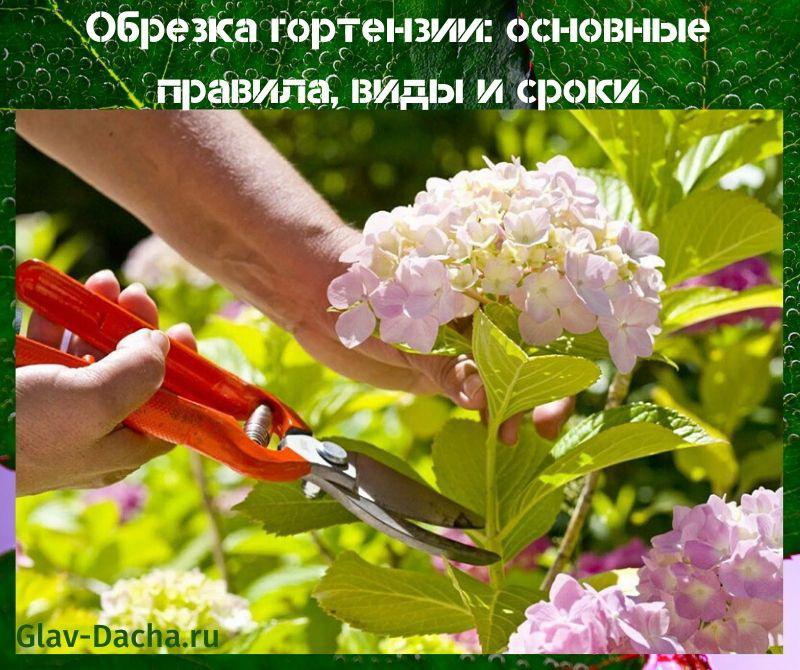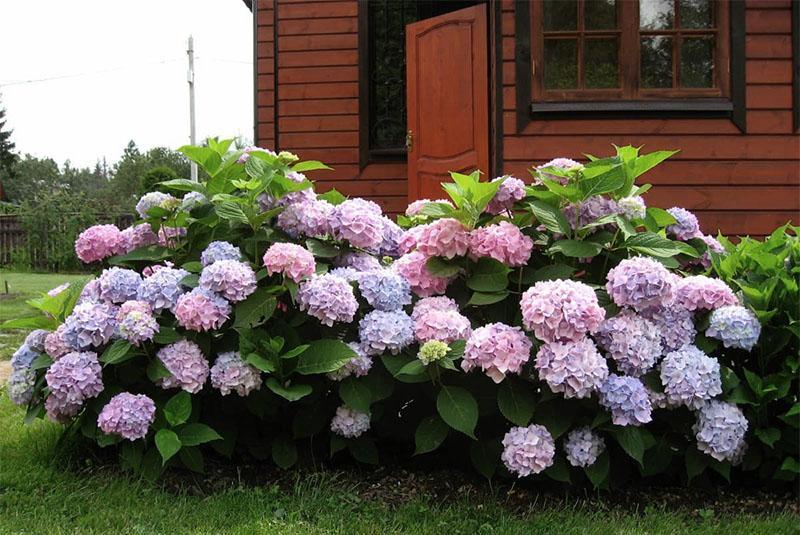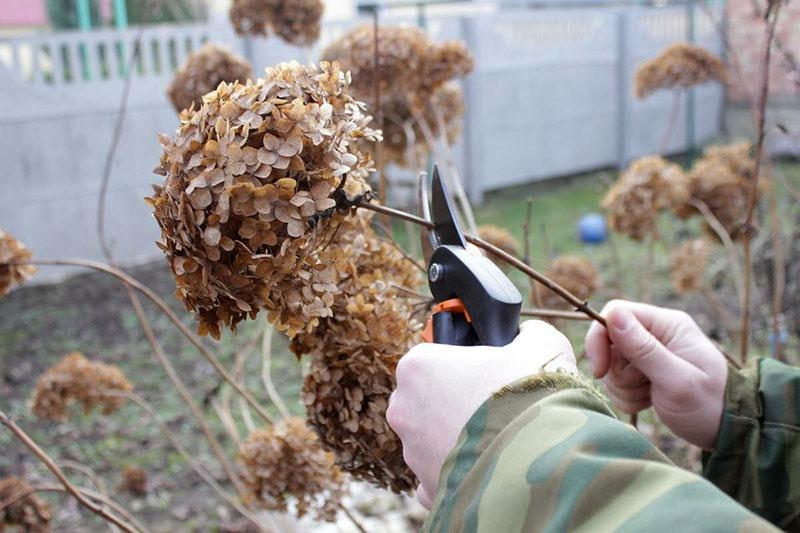Hydrangea pruning: basic rules, types and timing
 Hydrangea pruning is one of the important stages of plant agricultural technology. This procedure should be carried out in the fall and spring. In this case, the exact timing is important, they affect the subsequent growth and development of culture. In order to perform pruning correctly, you should know that there are different types of procedure, each of which has its own function and is required by the plant at different stages of development.
Hydrangea pruning is one of the important stages of plant agricultural technology. This procedure should be carried out in the fall and spring. In this case, the exact timing is important, they affect the subsequent growth and development of culture. In order to perform pruning correctly, you should know that there are different types of procedure, each of which has its own function and is required by the plant at different stages of development.
Why do you need hydrangea pruning

Lush bush able to decorate any area, especially during the flowering period. But for this he needs regular pruning at a certain time. Hydrangea pruning is an important procedure, it is one of the components of proper plant care.
It is necessary in the following cases:
- giving the required shape to the bush and decorativeness;
- getting larger flowers and longer flowering;
- prevention of disease and pest attacks;
- removing old, dry, rotten stems.
The hydrangea is often shaped like a trunk. This is a real decoration for the site. This also requires proper pruning.
Types of trimming
 There are several types of hydrangea pruning, each of which is necessary for the plant at one time and is made for specific purposes.
There are several types of hydrangea pruning, each of which is necessary for the plant at one time and is made for specific purposes.
Among them, the following types are distinguished:
- sanitary;
- formative;
- regulatory;
- anti-aging.
Sanitary pruning is done in the fall after the plant has stopped flowering. The main goal and task is to free the culture from old, dry, broken, diseased or rotten branches, inflorescences. Serious pruning is sometimes required if the hydrangea is sick or heavily attacked by pests.
If the growing region is rather cold, then for the first couple of years only sanitary pruning needs to be done, since the culture takes a lot of energy for the winter period.
Anti-aging pruning is equally important. It is necessary to remove old branches that interfere with the development of young and healthy stems. If it is not produced, then sooner or later the bush will stop growing correctly and fully, the leaf plates are crushed, and flowering will become scarce or stop altogether.
Regulating or stimulating pruning allows the plant to bloom beautifully and luxuriantly, and most importantly, to delight with large inflorescences for a long period of time. This type of pruning is often combined with regular thinning, which avoids excessive thickening, the more the hydrangea is prone to it.
Formative pruning is especially important in the early years of culture. It forms the crown, gives it the desired shape. During the procedure, it is necessary to pay special attention to the skeletal branches, which act as a support for the plant. If the gardener does not perform this type of pruning, then the absence of strong branches will be observed and the bush develops incorrectly.
Initially, pruning is carried out during planting of the seedling, removing weak and broken shoots. Next, you need to give the culture an opportunity to grow stronger and take root.Thus, the second pruning should take place in the spring before the sap flow begins, for example, in March.
Some time ago, many gardeners considered it effective to prune a seedling under a stump. This greatly simplified the procedure, but was negatively reflected in the subsequent development and flowering of the bush. For this reason, almost no one produces it now.
Starting from 3 years of culture life, you can use standard types of pruning - stimulating, shaping, rejuvenating.
Dates of the procedure
 Cropping the crop must be timely. The most favorable terms for the procedure are in spring and autumn. The decorative qualities and condition of the bush depend on compliance with the period.
Cropping the crop must be timely. The most favorable terms for the procedure are in spring and autumn. The decorative qualities and condition of the bush depend on compliance with the period.
Spring pruning
 In some cases, especially during formative pruning, the procedure should be started when the buds are already swollen - they will indicate in which direction the young branches are growing. Until this point becomes clear, you do not need to start pruning. As this can lead to improper formation of the bush. However, it is important not to miss the moment, because the flowering time will shift, and in the future the culture will not have time to prepare for the winter period.
In some cases, especially during formative pruning, the procedure should be started when the buds are already swollen - they will indicate in which direction the young branches are growing. Until this point becomes clear, you do not need to start pruning. As this can lead to improper formation of the bush. However, it is important not to miss the moment, because the flowering time will shift, and in the future the culture will not have time to prepare for the winter period.
It is important first of all to prune a tree hydrangea, and then a panicle - it is the most hardy and less sensitive to this procedure.
Autumn pruning
 It is important for an adult hydrangea to prune in the fall every year. The procedure should be started after the end of flowering, when the inflorescences dry up, the leaves fall off. It starts with the smallest branches, gradually moving deeper into the bush. Old and broken branches are cut off almost to the very base, young ones are not affected.
It is important for an adult hydrangea to prune in the fall every year. The procedure should be started after the end of flowering, when the inflorescences dry up, the leaves fall off. It starts with the smallest branches, gradually moving deeper into the bush. Old and broken branches are cut off almost to the very base, young ones are not affected.
It is recommended to radically prune large-leaved hydrangeas every 4 years. To do this, at right angles, you need to cut off all branches at a level of 45 cm from the ground.
Most often, pruning is done in October. It is necessary that the temperature is kept in the region of 5-10 ° C. If we are talking about a frost-resistant hydrangea, then the procedure can be postponed to November. It is important to take into account the place of growth. If the culture grows in the northern regions, then pruning in the fall should be more gentle. Hydrangea, which is not a frost-resistant variety, does not react well to cold weather, so longer branches will remain protected for the winter. In particular, this applies to large-leaved hydrangea, as it is thermophilic.
Experienced gardeners, with proper autumn pruning, do not need to repeat this procedure in the spring. In rare cases, it will be necessary to remove frost-damaged branches.
Features of pruning different types of hydrangea
 Panicle hydrangea is a small tree with a spreading crown. The young plant must be properly shaped, and the mature and mature tree must be pruned regularly. In this case, you can get a decorative crown. By trimming panicle hydrangea correctly, you can count on the beautiful flowering of the plant. It requires mandatory sanitary pruning in the spring. Most often it is held in March. In addition to removing all dry and damaged branches, annual shoots should be shortened so that no more than 3-5 buds remain on them. The bush is thinned well, avoiding thickening. Particular attention is paid to strong healthy shoots - 1-2 shoots should be left on them. Generally, the stronger the branch, the more buds it should keep. During flowering, it is they who will provide quality flowering to the entire bush.
Panicle hydrangea is a small tree with a spreading crown. The young plant must be properly shaped, and the mature and mature tree must be pruned regularly. In this case, you can get a decorative crown. By trimming panicle hydrangea correctly, you can count on the beautiful flowering of the plant. It requires mandatory sanitary pruning in the spring. Most often it is held in March. In addition to removing all dry and damaged branches, annual shoots should be shortened so that no more than 3-5 buds remain on them. The bush is thinned well, avoiding thickening. Particular attention is paid to strong healthy shoots - 1-2 shoots should be left on them. Generally, the stronger the branch, the more buds it should keep. During flowering, it is they who will provide quality flowering to the entire bush.
 Pruning and shaping a large-leaved hydrangea is, first of all, that the shoots are not shortened too much. The only exceptions are frozen specimens. Pruning short may prevent flowering. This type of hydrangea is a shrub on which zero shoots are formed annually, and 5-year-olds become old. Flowering shoots are formed from the upper buds of last year.Therefore, in winter, it is important to preserve young branches, their tops, which did not bloom in the current year - they will show themselves in the next.
Pruning and shaping a large-leaved hydrangea is, first of all, that the shoots are not shortened too much. The only exceptions are frozen specimens. Pruning short may prevent flowering. This type of hydrangea is a shrub on which zero shoots are formed annually, and 5-year-olds become old. Flowering shoots are formed from the upper buds of last year.Therefore, in winter, it is important to preserve young branches, their tops, which did not bloom in the current year - they will show themselves in the next.
 Treelike hydrangea is cut according to a special scheme. In autumn, only spherical inflorescences need to be cut, and in spring, sanitary and rejuvenating pruning will be required. For good flowering, it is necessary to shorten the strong shoots by 4 pairs of buds. During thinning pruning, it is important to remove all weak, incapable of flowering branches, as well as zero ones that appear on the sides of the shrub. This is necessary to maintain shape and maintain strength for subsequent flowering.
Treelike hydrangea is cut according to a special scheme. In autumn, only spherical inflorescences need to be cut, and in spring, sanitary and rejuvenating pruning will be required. For good flowering, it is necessary to shorten the strong shoots by 4 pairs of buds. During thinning pruning, it is important to remove all weak, incapable of flowering branches, as well as zero ones that appear on the sides of the shrub. This is necessary to maintain shape and maintain strength for subsequent flowering.
Newbies in horticulture are advised to prune gradually, starting with sanitary and thinning.
Formation of the trunk
 Blooming hydrangea can often be seen on a trunk. It looks attractive - a ball is formed on a long trunk. This requires certain skills, but there are no difficulties in this procedure.
Blooming hydrangea can often be seen on a trunk. It looks attractive - a ball is formed on a long trunk. This requires certain skills, but there are no difficulties in this procedure.
The work algorithm is as follows:
- Starting from the second year, in the spring, you need to choose the strongest shoot, and remove the rest.
- Remove the shoot to the strongest bud, which has already been outlined.
- These actions must be continued until the shoot is at least 1 m tall. This will require 2-3 trims.
- Then you can start forming the ball. This is easy to do, leaving up to the five strongest shoots. The rest should be removed.
In the future, you need to ensure that the future tree does not grow upward, pinching the upper bud of the trunk.
Care after pruning

Competent care of hydrangea after the pruning procedure is as follows:
- timely feeding;
- loosening the soil and mulching;
- regular watering;
- preventive spraying against diseases and pests.
Top dressing is important for the correct formation of strong shoots and a large leaf plate. The plant needs mineral and organic fertilizers. When using them, you need to follow the instructions, follow the recommended dosage.
In the process of mulching the soil, it must be borne in mind that the layer of mulch should be at least 15 cm. Straw, sawdust, crushed bark are suitable for it.
As for irrigation, its regime must be set based on weather conditions and climate. However, you need to keep in mind that hydrangea loves abundant watering.